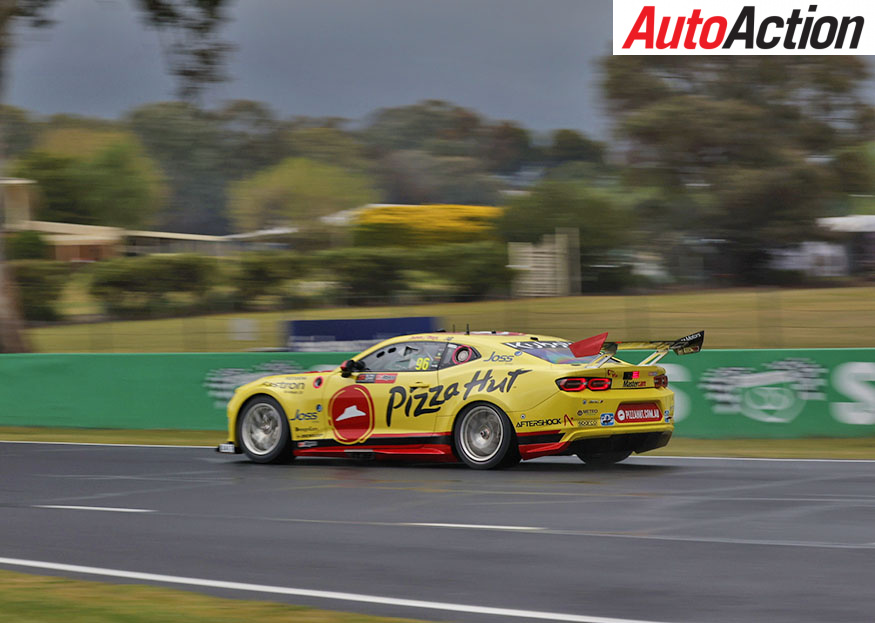Ford pushes for engine map change as balance of performance enters the debate

By Andrew Clarke
Date posted: 9 October 2025
Supercars will review day one data at Mount Panorama overnight, with Ford pressing for an engine calibration update and Chevrolet teams resisting any mid-event changes after Camaros reportedly topped the speed microsectors on Thursday.
Supercars head of motorsport, Tim Edwards, said the Mustang package introduced at The Bend was designed with Bathurst in mind, and he does not expect any adjustments this weekend. However, he acknowledged that compelling data could trigger action if the numbers breach parity thresholds. With further aerodynamic changes off the table, an engine map refinement remains Ford’s only viable lever heading into qualifying.
The rumoured formal parity meeting will test the Mustang’s outputs against the category’s parity windows, comparing sector overlays, trap speeds and power-delivery curves to the approved models. If the results sit inside the accepted range, no changes will be approved. If they fall outside, Supercars can green-light a narrow calibration update.
Triple Eight and other Chevrolet squads have made their stance clear: no shift to the baseline without hard evidence. Bathurst’s altitude and long full-throttle sections magnify torque and drag differences, and set-up changes can have a dramatic effect on top speeds. Chevrolet argues the current specification was validated before the enduros and should stand for the weekend unless data proves otherwise.
The stakes extend beyond Ford versus Chevrolet. The discussion is growing around whether Supercars’ existing parity framework can withstand the grid’s expansion to three brands next year. The term Balance of Performance, long resisted in Supercars circles, is being raised more frequently by team insiders who fear the process could drift that way by necessity rather than design.
The 2026 GR Supra, which will turn demonstration laps tomorrow, has reignited that discussion. Its curvaceous bodywork diverges sharply from the slab-sided Camaro and Mustang silhouettes. While its surfaces align closely with those of the road car, they create natural aerodynamic characteristics that could be difficult to match through conventional Gen3 parity tools.
Engineers across the paddock are already wondering whether a BoP-style model will ultimately be required to harmonise such different body shapes.
Supercars insists it has a strong, data-driven parity process anchored in transient-dyno and wind-tunnel validation despite making changes for The Bend. The challenge will be applying that framework to three cars with such different philosophies without opening the door to subjective balancing.
For Ford, the debate has added weight.
Over the past two seasons, Ford’s engine program has been benchmarked against Chevrolet’s pushrod architecture, the parity model requiring Ford to tune its newer power unit to match the Camaro’s older configuration. With Toyota joining the fight using a similar modern engine to Ford, some are calling for that baseline to flip, to make Chevrolet match Ford and Toyota instead.
Whether that is feasible remains unclear, but the argument underscores the growing friction between parity and performance as Supercars edges toward its three-brand era.
For now, the focus remains on Bathurst. Ford says the data justifies an engine calibration refinement, Chevrolet disagrees and wants stability. What happens at the rumoured parity meeting will set the tone not only for Sunday’s race, but for how the sport defines performance equality in 2026 and beyond.
Recent Stories
array (
0 =>
WP_Term::__set_state(array(
'term_id' => 11,
'name' => 'Latest News',
'slug' => 'latest-news',
'term_group' => 0,
'term_taxonomy_id' => 11,
'taxonomy' => 'category',
'description' => '',
'parent' => 0,
'count' => 16850,
'filter' => 'raw',
'cat_ID' => 11,
'category_count' => 16850,
'category_description' => '',
'cat_name' => 'Latest News',
'category_nicename' => 'latest-news',
'category_parent' => 0,
)),
1 =>
WP_Term::__set_state(array(
'term_id' => 38,
'name' => 'Supercars',
'slug' => 'supercars',
'term_group' => 0,
'term_taxonomy_id' => 38,
'taxonomy' => 'category',
'description' => 'The Supercars Championship, currently known as the Repco Supercars Championship, is the premier motorsport category in Australasia and one of Australia\'s biggest sports. It originated from the Australian Touring Car Championship (ATCC), which held its first race in 1960 at Gnoo-Blas in Orange, New South Wales. The ATCC evolved over the years, and in 1997, it was rebranded as the V8 Supercars Championship, eventually becoming the Supercars Championship we know today.
Some of the leading drivers in the history of the Supercars Championship include Peter Brock, who is often referred to as the "King of the Mountain" for his nine victories at the Bathurst 1000, a race that is considered one of the biggest in the series. Other notable drivers include Dick Johnson, Marcos Ambrose, Craig Lowndes, Shane van Gisbergen, Jamie Whincup, who holds the record for the most championship titles, and Mark Skaife, who has also been a dominant force in the series.
The Bathurst 1000, held at Mount Panorama Circuit in Bathurst, New South Wales, is arguably the most famous race in the Supercars calendar. Other significant races include the Sandown 500 and the Adelaide 500, which are known for their challenging circuits and thrilling competitions.
The Supercars Championship has grown to become a globally recognized series, known for its competitive racing and passionate fan base. It continues to be a major part of Australia\'s motorsport culture, attracting top drivers and teams from around the world.',
'parent' => 0,
'count' => 5648,
'filter' => 'raw',
'cat_ID' => 38,
'category_count' => 5648,
'category_description' => 'The Supercars Championship, currently known as the Repco Supercars Championship, is the premier motorsport category in Australasia and one of Australia\'s biggest sports. It originated from the Australian Touring Car Championship (ATCC), which held its first race in 1960 at Gnoo-Blas in Orange, New South Wales. The ATCC evolved over the years, and in 1997, it was rebranded as the V8 Supercars Championship, eventually becoming the Supercars Championship we know today.
Some of the leading drivers in the history of the Supercars Championship include Peter Brock, who is often referred to as the "King of the Mountain" for his nine victories at the Bathurst 1000, a race that is considered one of the biggest in the series. Other notable drivers include Dick Johnson, Marcos Ambrose, Craig Lowndes, Shane van Gisbergen, Jamie Whincup, who holds the record for the most championship titles, and Mark Skaife, who has also been a dominant force in the series.
The Bathurst 1000, held at Mount Panorama Circuit in Bathurst, New South Wales, is arguably the most famous race in the Supercars calendar. Other significant races include the Sandown 500 and the Adelaide 500, which are known for their challenging circuits and thrilling competitions.
The Supercars Championship has grown to become a globally recognized series, known for its competitive racing and passionate fan base. It continues to be a major part of Australia\'s motorsport culture, attracting top drivers and teams from around the world.',
'cat_name' => 'Supercars',
'category_nicename' => 'supercars',
'category_parent' => 0,
)),
2 =>
WP_Term::__set_state(array(
'term_id' => 2029,
'name' => 'ZZZ-Email',
'slug' => 'email',
'term_group' => 0,
'term_taxonomy_id' => 2029,
'taxonomy' => 'category',
'description' => '',
'parent' => 2031,
'count' => 7405,
'filter' => 'raw',
'cat_ID' => 2029,
'category_count' => 7405,
'category_description' => '',
'cat_name' => 'ZZZ-Email',
'category_nicename' => 'email',
'category_parent' => 2031,
)),
3 =>
WP_Term::__set_state(array(
'term_id' => 2031,
'name' => 'ZZZ-RSSFeeds',
'slug' => 'zzz-rssfeeds',
'term_group' => 0,
'term_taxonomy_id' => 2031,
'taxonomy' => 'category',
'description' => '',
'parent' => 0,
'count' => 6760,
'filter' => 'raw',
'cat_ID' => 2031,
'category_count' => 6760,
'category_description' => '',
'cat_name' => 'ZZZ-RSSFeeds',
'category_nicename' => 'zzz-rssfeeds',
'category_parent' => 0,
)),
)






